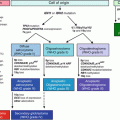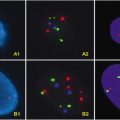36.
Scurry J, Beshay V, Cohen C, Allen D (1998) Ki67 expression in lichen sclerosus of vulva in patients with and without associated squamous cell carcinoma. Histopathology 32:399–404PubMed
37.
Serrano M, Hannon GJ, Beach D (1993) A new regulatory motif in cell cycle control causing specific inhibition of cycling D/CDK4. Nature 366:704–707PubMed
38.
Cobrinik D, Dowdy SF, Hinds PW, Mittnacht S, Weinberg RA (1992) The retinoblastoma protein and the regulation of cell cycling. Trends Biochem Sci 17:312–315PubMed
39.
Mantovani F, Banks L (2001) The human papillomavirus E6 protein and its contribution to malignant progression. Oncogene 20:7874–7887PubMed
40.
Munger K, Basile JR, Duensing S, Eichten A, Gonzalez SL, Grace M, Zacny VL (2001) Biological activities and molecular targets of the human papillomavirus E7 oncoprotein. Oncogene 20:7888–7898PubMed
41.
Khleif SN, DeGregori J, Yee CL, Otterson GA, Kaye FJ, Nevins JR, Howley PM (1996) Inhibition of cyclin D-CDK4/CDK6 activity is associated with an E2F-mediated induction of cyclin kinase inhibitor activity. Proc Natl Acad Sci U S A 93:4350–4354PubMed
42.
Cuschieri K, Wentzensen N (2008) Human papillomavirus mRNA and p16 detection as biomarkers for the improved diagnosis of cervical neoplasia. Cancer Epidemiol Biomarkers Prev 17:2536–2545PubMed
43.
Horree N, Heintz AP, Sie-Go DM, van Diest PJ (2007) p16 is consistently expressed in endometrial tubal metaplasia. Cell Oncol 29:37–45PubMed
44.
Bryce LA, Morrison N, Hoare SF, Muir S, Keith WN (2000) Mapping of the gene for the human telomerase reverse transcriptase, hTERT, to chromosome 5p15.33 by fluorescence in situ hybridization. Neoplasia 2:197–201PubMed
45.
Nakamura TM, Morin GB, Chapman KB, Weinrich SL, Andrews WH, Lingner J, Harley CB, Cech TR (1997) Telomerase catalytic subunit homologs from fission yeast and human. Science 277:955–959PubMed
46.
Kim NW, Piatyszek MA, Prowse KR, Harley CB, West MD, Ho PL, Coviello GM, Wright WE, Weinrich SL, Shay JW (1994) Specific association of human telomerase activity with immortal cells and cancer. Science 266:2011–2015PubMed
47.
Kailash U, Soundararajan CC, Lakshmy R, Arora R, Vivekanandhan S, Das BC (2006) Telomerase activity as an adjunct to high-risk human papillomavirus types 16 and 18 and cytology screening in cervical cancer. Br J Cancer 95(9):1250–1257, Epub 2006 Oct 24PubMed
48.
Sui W, Ou M, Dai Y, Chen J, Lan H, Yan Q, Huang H (2009) Gain of the human telomerase RNA gene TERC at 3q26 is strongly associated with cervical intraepithelial neoplasia and carcinoma. Int J Gynecol Cancer 19:1303–1306PubMed
49.
Ancuţa E, Ancuţa C, Cozma LG, Iordache C, Anghelache-Lupaşcu I, Anton E, Carasevici E, Chirieac R (2009) Tumor biomarkers in cervical cancer: focus on Ki-67 proliferation factor and E-cadherin expression. Rom J Morphol Embryol 50:413–418PubMed
50.
Yang A, Kaghad M, Wang Y, Gillett E, Fleming MD, Dötsch V, Andrews NC, Caput D, McKeon F (1998) p63, a p53 homolog at 3q27–29, encodes multiple products with transactivating, death-inducing, and dominant-negative activities. Mol Cell 2:305–316PubMed
51.
Shirendeb U, Hishikawa Y, Moriyama S, Win N, Thu MM, Mar KS, Khatanbaatar G, Masuzaki H, Koji T (2009) Human papillomavirus infection and its possible correlation with p63 expression in cervical cancer in Japan, Mongolia, and Myanmar. Acta Histochem Cytoc 42:181–190
52.
Khan MJ, Castle PE, Lorincz AT, Wacholder S, Sherman M, Scott DR, Rush BB, Glass AG, Schiffman M (2005) The elevated 10-year risk of cervical precancer and cancer in women with human papillomavirus (HPV) type 16 or 18 and the possible utility of type-specific HPV testing in clinical practice. Natl Cancer Inst 97:1072–1079
53.
Gravitt PE, Kovacic MB, Herrero R, Schiffman M, Bratti C, Hildesheim A, Morales J, Alfaro M, Sherman ME, Wacholder S, Rodriguez AC, Burk RD (2007) High load for most high risk human papillomavirus genotypes is associated with prevalent cervical cancer precursors but only HPV16 load predicts the development of incident disease. Int J Cancer 121:2787–2793PubMed
54.
Lamarcq L, Deeds J, Ginzinger D, Perry J, Padmanabha S, Smith-McCune K (2002) Measurements of human papillomavirus transcripts by real time quantitative reverse transcription-polymerase chain reaction in samples collected for cervical cancer screening. J Mol Diagn 4:97–102PubMed
55.
Gharizadeh B, Oggionni M, Zheng B, Akom E, Pourmand N, Ahmadian A, Wallin KL, Nyrén P (2005) Type-specific multiple sequencing primers: a novel strategy for reliable and rapid genotyping of human papillomaviruses by pyrosequencing technology. J Mol Diagn 7:198–205PubMed
56.
Schiffman MH, Kiviat NB, Burk RD, Shah KV, Daniel RW, Lewis R, Kuypers J, Manos MM, Scott DR, Sherman ME et al (1995) Accuracy and interlaboratory reliability of human papillomavirus DNA testing by hybrid capture. J Clin Microbiol 33:545–550PubMed
57.
Negri G, Rigo B, Vittadello F, Egarter-Vigl E, Mian C (2004) Human papillomavirus typing with hybrid capture II on archived liquid-based cytologic specimens: is HPV typing always reproducible? Am J Clin Pathol 122:90–93PubMed
58.
Brosens LA, van Hattem WA, Jansen M, de Leng WW, Giardiello FM, Offerhaus GJ (2007) Gastrointestinal polyposis syndromes. Curr Mol Med 7:29–46PubMed
59.
Boardman LA, Thibodeau SN, Schaid DJ, Lindor NM, McDonnell SK, Burgart LJ, Ahlquist DA, Podratz KC, Pittelkow M, Hartmann LC (1998) Increased risk for cancer in patients with the Peutz-Jeghers syndrome. Ann Intern Med 128:896–899PubMed
60.
Giardiello FM, Welsh SB, Hamilton SR, Offerhaus GJ, Gittelsohn AM, Booker SV, Krush AJ, Yardley JH, Luk GD (1987) Increased risk of cancer in the Peutz-Jeghers syndrome. N Engl J Med 316:1511–1514PubMed
61.
Karuman P, Gozani O, Odze RD et al (2001) The Peutz–Jegher gene product LKB1 is a mediator of p53-dependent cell death. Mol Cell 7:1307–1319PubMed
62.
Gong L, Zhang WD, Liu XY, Han XJ, Yao L, Zhu SJ, Lan M, Li YH, Zhang W (2010) Clonal status and clinicopathological observation of cervical minimal deviation adenocarcinoma. Diagn Pathol 5:25PubMed
63.
Young RH (2005) Sex cord-stromal tumors of the ovary and testis: their similarities and differences with consideration of selected problems. Mod Pathol 18(Suppl 2):S81–S98PubMed
64.
Howe JR, Roth S, Ringold JC, Summers RW, Järvinen HJ, Sistonen P, Tomlinson IP, Houlston RS, Bevan S, Mitros FA, Stone EM, Aaltonen LA (1998) Mutations in the SMAD4/DPC4 gene in juvenile polyposis. Science 280:1086–1088PubMed
65.
Calva-Cerqueira D, Chinnathambi S, Pechman B, Bair J, Larsen-Haidle J, Howe JR (2009) The rate of germline mutations and large deletions of SMAD4 and BMPR1A in juvenile polyposis. Clin Genet 75:79–85PubMed
66.
Sweet K, Willis J, Zhou XP, Gallione C, Sawada T, Alhopuro P, Khoo SK, Patocs A, Martin C, Bridgeman S, Heinz J, Pilarski R, Lehtonen R, Prior TW, Frebourg T, Teh BT, Marchuk DA, Aaltonen LA, Eng C (2005) Molecular classification of patients with unexplained hamartomatous and hyperplastic polyposis. JAMA 294:2465–2473PubMed
67.
Tavassoli FA, Devilee P (eds) (2003) World Health Organization classification of tumors: pathology and genetics. Tumours of the breast and female genital organs. IARC, Lyon
68.
Gilks CB, Prat J (2009) Ovarian carcinoma pathology and genetics: recent advances. Hum Pathol 40:1213–1223PubMed
69.
Auersperg N, Ota T, Mitchell GW (2002) Early events in ovarian epithelial carcinogenesis: progress and problems in experimental approaches. Int J Gynecol Cancer 12:691–703PubMed
70.
Brown ML, Riley GF, Schussler N, Etzioni RD (2002) Estimated health care costs related to cancer treatment from SEER-Medicare data. Medical Care 40(8 Suppl):IV104–IV117
71.
Gilks CB (2010) Molecular abnormalities in ovarian cancer subtypes other than high-grade serous carcinoma. J Oncol 2010:740968PubMed
72.
Malumbres M, Barbacid M (2003) RAS oncogenes: the first 30 years. Nat Rev Cancer 3:459–465PubMed
73.
Der CJ, Krontiris TG, Cooper GM (1982) Transforming genes of human bladder and lung carcinoma cell lines are homologous to the ras genes of Harvey and Kirsten sarcoma viruses. Proc Natl Acad Sci U S A 79:3637–3640PubMed
74.
Graziani A, Gramaglia D, dalla Zonca P, Comoglio PM (1993) Hepatocyte growth factor/scatter factor stimulates the Ras-guanine nucleotide exchanger. J Biol Chem 268:9165–9168PubMed
75.
Hu YP, Patil SB, Panasiewicz M, Li W, Hauser J, Humphrey LE, Brattain MG (2008) Heterogeneity of receptor function in colon carcinoma cells determined by cross-talk between type I insulin-like growth factor receptor and epidermal growth factor receptor. Cancer Res 68:8004–8013PubMed
77.
Yarden Y, Sliwkowski MX (2001) Untangling the ErbB signaling network. Nat Rev Mol Cell Biol 2:127–137PubMed
78.
Singer G, Oldt R 3rd, Cohen Y, Wang BG, Sidransky D, Kurman RJ, Shih I-M (2003) Mutations in BRAF and KRAS characterize the development of low-grade ovarian serous carcinoma. J Natl Cancer Inst 95:484–486PubMed
79.
Körner M, Burckhardt E, Mazzucchelli L (2006) Higher frequency of chromosomal aberrations in ovarian endometriosis compared to extragonadal endometriosis: a possible link to endometrioid adenocarcinoma. Mod Pathol 19:1615–1623PubMed
80.
Barault L, Veyrie N, Jooste V, Lecorre D, Chapusot C, Ferraz JM, Lièvre A, Cortet M, Bouvier AM, Rat P, Roignot P, Faivre J, Laurent-Puig P, Piard F (2008) Mutations in the RAS-MAPK, PI(3)K (phosphatidylinositol-3-OH kinase) signaling network correlate with poor survival in a population-based series of colon cancers. Int J Cancer 122:2255–2259PubMed
81.
Loupakis F, Ruzzo A, Cremolini C, Vincenzi B, Salvatore L, Santini D, Masi G, Stasi I, Canestrari E, Rulli E, Floriani I, Bencardino K, Galluccio N, Catalano V, Tonini G, Magnani M, Fontanini G, Basolo F, Falcone A, Graziano F (2009) KRAS codon 61, 146 and BRAF mutations predict resistance to cetuximab plus irinotecan in KRAS codon 12 and 13 wild-type metastatic colorectal cancer. Br J Cancer 101:715–721PubMed
82.
Benvenuti S, Sartore-Bianchi A, Di Nicolantonio F, Zanon C, Moroni M, Veronese S, Siena S, Bardelli A (2007) Oncogenic activation of the RAS/RAF signaling pathway impairs the response of metastatic colorectal cancers to anti-epidermal growth factor receptor antibody therapies. Cancer Res 67:2643–2648PubMed
83.
Mayr D, Hirschmann A, Löhrs U, Diebold J (2006) KRAS and BRAF mutations in ovarian tumors: a comprehensive study of invasive carcinomas, borderline tumors and extraovarian implants. Gynecol Oncol 103(3):883–887PubMed
Stay updated, free articles. Join our Telegram channel

Full access? Get Clinical Tree






